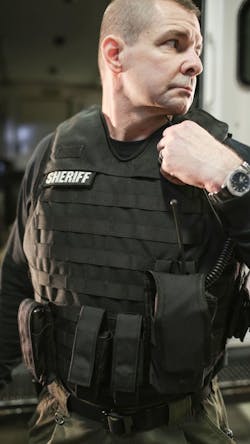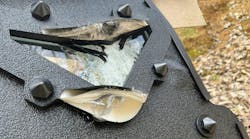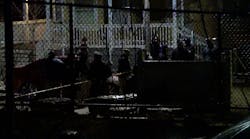Body armor can be the determining factor in police safety. Body armor manufacturers take into consideration every situation an officer may encounter while on duty, and new threats drive development including the materials used to make vests and the grades of durability offered.
Officer Brad Baker of the Denver (Colo.) Police Department says they are issued Level II and Level IIIA soft armor for routine patrol. “We also have steel plates and carriers for higher risk situations,” he says. Across the board, more and more departments are making ballistic vests mandatory uniform. The Tucson (Ariz.) Police Department requires officers to wear them at all times unless assigned to administrative duty, however, the officer must have easy access to their body armor if that is the case. One vest issued for their officers is a Level IIA at the least so the vest may be concealed use.
Body armor is not what it once was; rather, today’s body armor comes with relatively more comfort, adjustability and less weight all the while maintaining both function and safety.
Durability and comfort advancements
The technology implemented has grown, allowing vests to be durable and convenient for the officer. Propper International has recently introduced two designs that have been impactful on the law enforcement community. “Our Four Panel Vest (4PV) Concealable vest system is made for males or females specifically,” says Marcus Treiber, vice president of armor products. The fact that the vest is cut to suit the male or female body in particular, results in an overall better fit for the officer. “It is a solid shape panel that offers both coverage and comfort,” says Treiber.
4PV is a four paneled vest made of four, separate panels that offer protection without immobilizing the officer. Having two of the four panels on each side offers more protection in the field. In addition, each vest offers ballistic options with varying levels to guard against multiple grades of ammunition. Level IIA is suitable for protection against bullets such as 9mm. Level II and IIIA offer more protection. Level III and IV protection comes from hard plates able to withstand ammunition such as .30-06 caliber rifle bullets.
Officer Chris Menck of the Fredericksburg (Va.) Police Department says the 4PV vest is an overall great product. “It wraps the body,” he says. “The floating side panels offer a more practical design for side protection than traditional body armor.” Menck says the vest is slightly bulky initially but easy to adjust to once broken in. “The VELCRO straps are extremely secure and don’t seem to lose grip after years of usage.”
The Switch vest by Propper is able to accommodate scenarios for those involved in K9 units, sniper, or regular duty and offers levels of armor for each situation. This vest is low-profile and may be worn in many ways including under a business suit shirt or underneath a standard uniform. For added protection, the Switch vest allows room for soft body armor panels on the side as well.
Lightweight and customized
One of the key factors that makes a type of body armor successful is the freedom it gives the officer while still offering ultimate protection. Corporal Sarah Collins of the Lubbock (Texas) Police Department says the lighter and more flexible the body armor is, the easier it is to bend and move especially in regard to inner worn vests. “All armor, if properly worn, is constricting and hot,” says Collins. “However, the outer armor allows the officer to have a chance to cool off at times by unzipping the vest without having to undress.” Collins says the outer vests offer more mobility since the vest is not tucked into the uniform pants.
The weight of the vest is important, too, as it can help or hinder fatigue over the course of a long shift. The weight of each piece of gear can cause back pain over time. A lighter vest leads to less chance of discomfort.
The Frisco Police Department in Frisco, Texas equips its officers with two types of body armor from Point Blank. “We use a level two soft vest with the capability of stopping bullets from pistols,” says Sergeant Jeff Inmon. The Frisco PD also implements a steel plate, level III vest with the ability to stop rifle rounds.
Point Blank offers a variety of choices for departments including newer items such as integrating laminated material that is both light and strong. “It is stronger than the conventional Cordura nylon, reducing weight and increasing durability,” says Allan Thompson, product line manager of Point Blank. “This new laminated material allows PBE to produce designs that have laser cut features that allow us to eliminate conventional MOLLE webbing attachments.” The Bikini Plate Carrier (BPC) is one example of the implementation of a laser-cut design. Thompson says it is approximately one third of the weight of a conventional plate carrier but retains durability.
Another important element of body armor is the consideration of climate. Climate and wear are some of the determining factors for a time period when body armor must be replaced. For the Frisco PD, vests are replaced depending on what type it is. “Our soft body armor is replaced every four to five years,” says Sergeant Inmon. “Hard armor is replaced every ten.”
The average time suggested to replace body armor is every five years. “This is because the National Institute of Justice determined that there are too many environmental factors involving use and storage of body armor across the U.S. continent to allow for every variable,” says Thompson. Some armor may be used in a humid terrain, while others are exposed to extreme cold, or extreme heat, therefore an overall standard has been placed.
On top of the desire for functional, lightweight armor, agencies are also looking for customization. Instead of choosing a standard size based on the officer, customization allows the vest to be molded according to the officer and even to suit men or women. Companies such as Propper and Point Blank offer manufacturing panels that are specifically cut to suit the officer, maximizing comfort and effectiveness. When the vest is made for a particular officer, the fit is ideal, allowing the officer to wear the vest without having to adjust it constantly or hindering them at any point.
As demands change, so should the armor
Departments often issue two types of armor to fit varying encounters that personnel face on duty. It is important to be prepared at all times ensuring officers have a proper vest for low risk and high risk situations. Jon MacNeil, director of ballistic research and development for Armor Express, says the demands of body armor needs in law enforcement are ever-changing and many agencies are modifying the requirements they once had in place. “New and emerging threats are driving the development of high-performance, more flexible and more comfortable protective solutions,” says MacNeil.
Companies such as Armor Express are constantly collaborating with agencies and material and technology manufacturers in order to ensure that all officers have only the best protection when it comes to their gear. Their newest armor includes the soft armor Gen2 Razor and the C-Shock plate which offers rifle protection and are able to fit easily into their vests.
Steel plates are also becoming more standard issue protection for officers, especially those who may encounter high stress environments more often. Emily Chatterley, marketing manager for Angel Armor says their RISE vest when paired with their Truth SNAP plates is designed for all-day, concealable rifle protection. These magnetic body armor plates can be placed into the RISE vest for the highest amount of protection. Standard issue equips officers with both soft armor and hard.
The level of protection given is based on the type of assignment the officer is going into. In the Texas Department of Public Safety, troopers are issued both Level IIIA for a shirt carrier as well as Level IV rifle vests in the unit. In addition to ballistics vests, personnel are provided a Kevlar helmet.
Though there are advantages to both inner vests and outer, wearing a ballistic vest outside of the uniform is the most comfortable. The ability to adjust the vest while on shift easily or even remove it when safe is a benefit for personnel. As body armor continues to be refined, officers may find in future a vest worn in any capacity is more than sufficient for comfort, function, and most importantly safety.



